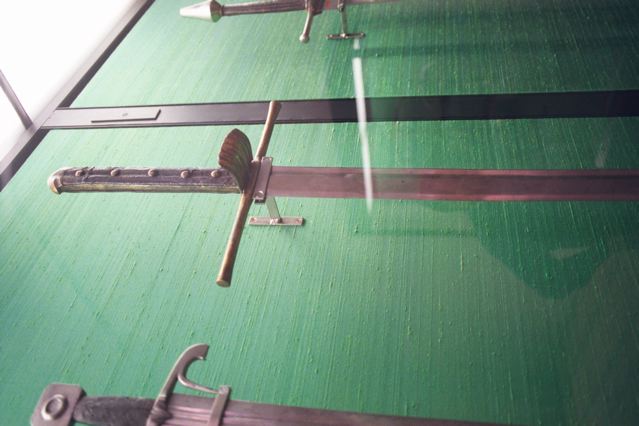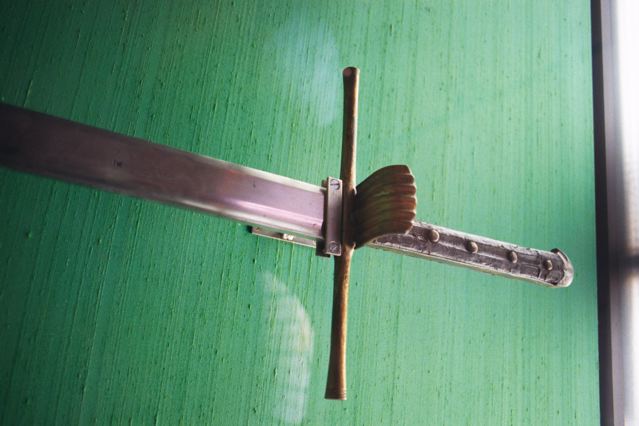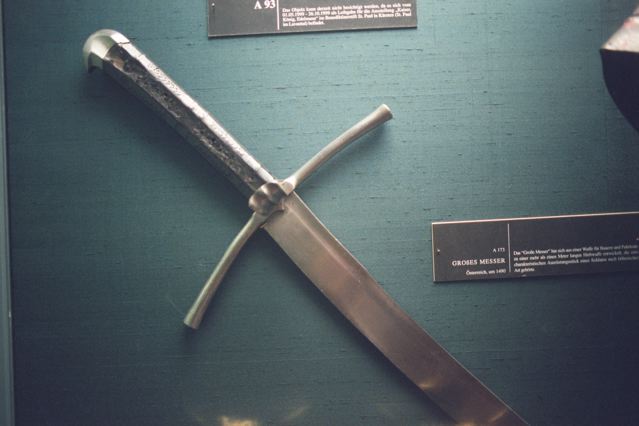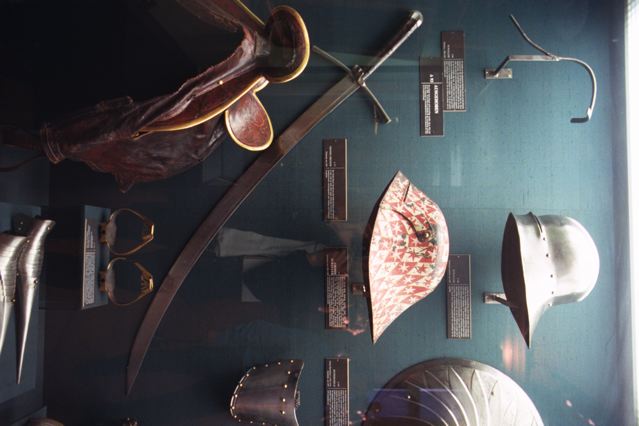
Any info and/or photos of this wonderful messer would be much appriciated;
 Attachment: 114.73 KB
Attachment: 114.73 KB


Also wondering how a kriegsmesser was sharpened? Like a sword or like a big knife?
| W. Schütz wrote: |
| Any info and/or photos of this wonderful messer would be much appriciated; |
Where did this photo some from? That might help us help you.
This is a famous Kriegsmesser from the Imperial Collection in Wienna.
In the catalogue of the armoury it is dated to around 1490.
The pommel is described as bird shaped. Grip scales are covered with black leather and fastened with five gilded rivets. Both pommel and guard are also gilded.
War knives such as this belong to the Bohemian tradition and might have been carried by the bannerman of Bohemia in the Triumph of Maximilian I.
This weapon has been published by Seitz: Blankwaffen Vol.1 p. 195.
I attach two snapshots of the same messer as seen in the exhibition in Wienna.
Also attached are two photos of a larger specimen from the same collection.
Finally a drawing by Seitz in his blankwaffen showing the same two weapons plus a third in the same collection. They are all drawn to the same scale. Note differences in size, proportions and blade shape.
 Attachment: 42.58 KB
Attachment: 42.58 KB

 Attachment: 42.57 KB
Attachment: 42.57 KB

 Attachment: 35.17 KB
Attachment: 35.17 KB

 Attachment: 42.24 KB
Attachment: 42.24 KB

 Attachment: 29.19 KB
Attachment: 29.19 KB

In the catalogue of the armoury it is dated to around 1490.
The pommel is described as bird shaped. Grip scales are covered with black leather and fastened with five gilded rivets. Both pommel and guard are also gilded.
War knives such as this belong to the Bohemian tradition and might have been carried by the bannerman of Bohemia in the Triumph of Maximilian I.
This weapon has been published by Seitz: Blankwaffen Vol.1 p. 195.
I attach two snapshots of the same messer as seen in the exhibition in Wienna.
Also attached are two photos of a larger specimen from the same collection.
Finally a drawing by Seitz in his blankwaffen showing the same two weapons plus a third in the same collection. They are all drawn to the same scale. Note differences in size, proportions and blade shape.





| W. Schütz wrote: |
| Also wondering how a kriegsmesser was sharpened? Like a sword or like a big knife? |
A kriegsmesser is sharpened like a sword. It is used like a sword after all...
In the photos in my post above you´ll notice how the fiirst one has a 6mm edge bevel that is sharpened without secondary bevel all the way to the edge.
The second messer has a traditional gradual bevel that arcs down to shapness in an acute apple seed section.
You do find edged weapons that has a very narrow edge bevel that is sharply defined, shaping the very sharpness of the sword. This type of sharpening is somewhat similar to what is now described as a "knife edge".
You see it sometimes on weapons that has been resharpened (although this is in no way the norm) or sometimes on weapons that has unusually thin cross sections and acutely angeled main bevels, both single edged and double edged blades.
The edge geometry of war knives follow the same logics and principles as that of swords.
Big thanks for the info and photos.
It is interesting to me that the slabs are leather wrapped, and that the rivets are gilded. The common [modern] way of thinking is that messers are commoners' weapons, and are very simplistic. This one even has a decorative nagel, so it would seem to have belonged to someone with some money.
Hi!
It might be interesting to note the angle of the grip on the second one. (the one under the huge sallet) With this angle it looks really like the sabres of its age although this one is really huge so I doubt that it was used like a sabre but if it was I think it was sharpened sword like.
Regards!
It might be interesting to note the angle of the grip on the second one. (the one under the huge sallet) With this angle it looks really like the sabres of its age although this one is really huge so I doubt that it was used like a sabre but if it was I think it was sharpened sword like.
Regards!
| Bill Grandy wrote: |
| It is interesting to me that the slabs are leather wrapped, and that the rivets are gilded. The common [modern] way of thinking is that messers are commoners' weapons, and are very simplistic. This one even has a decorative nagel, so it would seem to have belonged to someone with some money. |
There are examples of very ornate messers such as this example belonging to Maximilian I and dating circa 1496.
[ Linked Image ]
I believe this is the same one. It's believed to be one used the guards of Maximilian I.
Here is the Italian text from its entry:
 Attachment: 13.37 KB
Attachment: 13.37 KB

Here is the Italian text from its entry:
| Quote: |
|
134. Veneto, c. 1490 Colteio da guerra per le guardie deil’imperatore Massimiiiano I Vienna, WS A 123 Irnpugnatura lunga, faccettata, coperta di pelle scura tenuta da borchie; e chiusa in alto da un cappellotto di bronzo sgusciato, già dorato. Bracci a sezione di tondino, patenti, con la crociera difesa da un conchigliotto sgusciato, già dorato. Larna poco curva, a fib e punta, rnarcata al forte, con una scanalatura lungo il dorso. L’uso è nettamente austriaco, rna l’arrna è stata senz’altro fabbricata nel Veneto Settentrionale. La marca costituisce una delle tante varianti dell’incudine coronata. LETT.: 1961, Gamber, p. 14 e 31, f. 27; 1965, Seitz, I, p. 195 e 355, f. 125 e 262; 1967, Wagner, p. 203, t. 3. |

| Bill Grandy wrote: |
| It is interesting to me that the slabs are leather wrapped, and that the rivets are gilded. The common [modern] way of thinking is that messers are commoners' weapons, and are very simplistic. This one even has a decorative nagel, so it would seem to have belonged to someone with some money. |
It's like a lot of other weapon types of the era, it started out as a simple peasants expedient, and then professional warriors began to use them, soon aristocratic warriors. The idea was refined and often became fashionable. You can see more or less the same process in the evolution of the halberd, the bill, the longbow, the crossbow (which became fashionable among nobility for hunting at least, if not warfare) the poll-axe, the flail, and even the firearm. Fancy and utilitarian versions of many of these weapons existed side by side through the ages, the former often barely recognizable as being the same weapon as the latter, though functionally it is. A 'fancy' messer and an ordinary one look roughly the same, but with a bit of gilding suddenly it looks more socially acceptable...
Messers were definitely one of those used by both nobles and common rabble such as myself :)
J
| Chad Arnow wrote: | ||
| I believe this is the same one. It's believed to be one used the guards of Maximilian I.
Here is the Italian text from its entry:
|
veneto region, around 1490
War knife for the guards of the emperor Maximilian the first.
Long faceted handle, covered with dark leather, kept in place by studs., closed in the upper part by a beveled cap of once gilt bronze.
Arms (cross arms) with round section (rebar section), patenti (? hmmm?, this is a technical os of the word I have to check), with the cross being defended by a fullered shell, once gilt.
Blade slightly curve, "a fib e punta" (wrong text, means nothing), with mark at the forte, with a fullered back.
The use of such blades is definitely austrian, however the blade was with absolute certainity built in the north of the Veneto region.
The marking is one of the many variants of the crowned anvil.
| Bruno Giordan wrote: |
| veneto region, around 1490
War knife for the guards of the emperor Maximilian the first. Long faceted handle, covered with dark leather, kept in place by studs., closed in the upper part by a beveled cap of once gilt bronze. Arms (cross arms) with round section (rebar section), patenti (? hmmm?, this is a technical os of the word I have to check), with the cross being defended by a fullered shell, once gilt. Blade slightly curve, "a fib e punta" (wrong text, means nothing), with mark at the forte, with a fullered back. The use of such blades is definitely austrian, however the blade was with absolute certainity built in the north of the Veneto region. The marking is one of the many variants of the crowned anvil. |
Bruno,
Thanks for the translation. I'm not surprised that there are some gibberish words, as I used my old OCR (optical character recognition) software for the first time when I scanned that text. :)
As I intend to buy a Grosses Messer next year (better, hope my smith make it..) and I´m looking about something more unusual, I like the style of the right one on the drawing with the solid blade...has anybody some information, photos or details of this or similare? Thanks a lot
Peter
Peter
| Peter Dietl wrote: |
| As I intend to buy a Grosses Messer next year (better, hope my smith make it..) and I´m looking about something more unusual, I like the style of the right one on the drawing with the solid blade...has anybody some information, photos or details of this or similare? Thanks a lot
Peter |
That one I saw when I visited the Imperial Armoury several years ago. It was displayed with a standing figure in armour and equipment in the stairs going up to the exhibit halls.
You could not see the full weapon as it was shielded by a pavise (I think).
The grip on it was, as I remember fully covered by leather.
I have seen other messers that are smaller in scale (short and broad but with pretty long grips) but that follow the same outline and character as this one. They are wide and thin in the blade with flat ground triangular section. The edge is apple seed shaped in section and shaped in the margin of the blade towards the sharpness. Some times there is a narrow grove or fuller running along the back. Sometimes there is a short false edge at the point.
The big one in Wienna would be about 6-7 cm wide at the base with a blade length of some 85-90 cm. I would venture a guess that the blade is about 5-6 mm thick at the base, tapering quickly down to around 4 mm, going down to about 2 mm at the point.
Think Sarbatier Chef´s knife 5 times normal size, sharpened like a sword: strudy at the base, fine at the point. This is not a lumber jack tool, but an agile weapon. The outline belies its feel and heft.
Thanks Peter,
now I´m looking for someone to make it, I already told Mark Vickers and he´s now thinking about the price...hope, I can hold it in my hands next year.
Peter
now I´m looking for someone to make it, I already told Mark Vickers and he´s now thinking about the price...hope, I can hold it in my hands next year.
Peter
Page 1 of 1
You cannot post new topics in this forumYou cannot reply to topics in this forum
You cannot edit your posts in this forum
You cannot delete your posts in this forum
You cannot vote in polls in this forum
You cannot attach files in this forum
You can download files in this forum
All contents © Copyright 2003-2006 myArmoury.com — All rights reserved
Discussion forums powered by phpBB © The phpBB Group
Switch to the Full-featured Version of the forum
Discussion forums powered by phpBB © The phpBB Group
Switch to the Full-featured Version of the forum